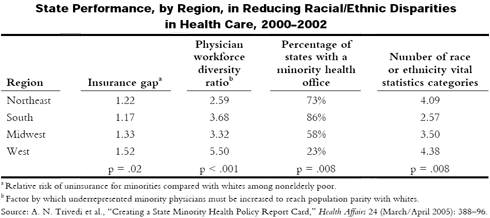In the first "report card" to evaluate all 50 states on their progress in addressing disparities in minority health care, researchers have found that high- and low-performing states tend to cluster geographically. Indeed, location was the only factor that consistently correlated with performance.
Using four report-card measures—insurance gap, physician workforce diversity, presence of a state Office of Minority Health, and the number of race or ethnicity vital statistics categories reported by the state—the research team found that "region of the country was a significant predictor of performance on all four measures." In particular, the researchers noted, states in the West tended to score poorly—below the national average—on three of four measures.
In "Creating a State Minority Health Policy Report Card," Amal N. Trivedi, M.D., M.P.H., of Harvard Medical School, and colleagues report on these results and others. The study, supported by The Commonwealth Fund, together with several other foundations and federal agencies, is published in the March/April 2005 issue of Health Affairs, which focuses on racial and ethnic health disparities.
Data and Methods
Trivedi and colleagues opted not to evaluate the states based on disparities in health outcomes "but rather on more proximate measures of effort, leadership, capacity, and infrastructure that would be sensitive to direct policy interventions." They devised the following four key variables:
- Insurance gap. Used to compare insurance coverage—specifically, rates of uninsurance—for minorities relative to whites. Defined as the percentage of the state's low-income, nonelderly minorities who are uninsured, divided by the percentage of low-income, nonelderly whites who are uninsured.
- Physician workforce diversity. Used to measure the degree to which a state's physician composition reflects its demographic composition. Underrepresented minority (URM) physicians were defined as African American, Native American, and Latino. This figure represents the factor by which the number of URM physicians must be increased to reach population parity with whites.
- Presence of a minority health office. Through a telephone survey, the researchers assessed the status and strength of existing offices, as illustrated by funding, staffing, scope of activities, and history.
- Number of race or ethnicity statistics. Federal health statistics data are reported using one ethnicity and five race categories, as stipulated by the Office of Management and Budget (OMB). For this measure, the researchers obtained the most recently published state vital statistics and analyzed how each state reported its mortality data. This number could range from one to five.
Study Results
The insurance ratios of the states varied considerably. While 11 states showed minimal differences between minorities and whites, 13 states had a 50–100 percent difference. Similarly, while the proportion of URM physicians in a few states reflected the local demographic composition, 18 states would need to raise their number of such physicians by a factor of 4.5 to 11.5 to achieve parity with white colleagues.
State minority health offices also showed tremendous variation in financial and human resources allocations. For example, California, which has a minority population of more than 17 million, has an Office of Minority Health budget of $275,000, or 1.5 cents per minority resident. By contrast, Minnesota, a state with a minority population of about 500,000, allocates $9.5 million to its office—resulting in per capita spending 1,200 times higher than that of California.
Health statistics data collection also varied widely. Nearly half of the states report mortality data using three or fewer race or ethnicity categories. In Mississippi, for instance, a report from 2001 describes the racial breakdown as "white" and "non-white." None of the states report on all six OMB categories.
The research team found that geographic region was a significant predictor of performance on all four report card measures. Western states had larger insurance disparities, less diverse physician workforces, and were less likely to have an Office of Minority Health than the national average. However, they were more likely to report more race and ethnicity categories. States in the South had significantly fewer insurance disparities, but also collected data in fewer categories.
While the four report card measures are not comprehensive, the authors acknowledge, these variables do reflect important aspects of minority health policy. Recent health disparities legislation introduced in the U.S. Senate (S. 2091), for example, included key provisions to target minority populations for enrollment in Medicaid, increase the diversity of health professions, and expand health data collection. Multifaceted interventions like these will be necessary, the researchers say, to eliminate disparities and achieve health equity.
Facts and Figures
- Only 30 of 50 states have a dedicated office of minority health.
- Nearly one-third of the states report mortality data using a "white-other," "black-white," or "black-white-other" racial breakdown.
- States with the highest proportion of minorities had physician workforces that were the least reflective of their demographic composition.
- The study found no consistent association between the four performance measures and either state fiscal capacity or percentage of minorities in the state.
